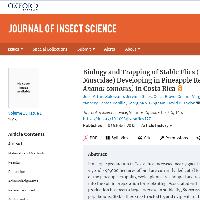Resumen
- Pineapple production in Costa Rica increased nearly 300-fold during the last 30 yr, and >40,000 hectares of land are currently dedicated to this crop. At the end of the pineapple cropping cycle, plants are chopped and residues incorporated into the soil in preparation for replanting. Associated with increased pineapple production has been a large increase in stable fly, Stomoxys calcitrans (L.), populations. Stable flies are attracted to, and oviposit in, the decomposing, chopped pineapple residues. In conjunction with chemical control of developing larvae, adult trapping is an important control strategy. In this study, four blue-black fabric traps, Nzi, Vavoua, Model H, and Ngu, were compared with a white sticky trap currently used for stable fly control in Costa Rica. Overall, the white sticky trap caught the highest number of stable flies, followed by the Nzi, Vavoua, Model H, and Ngu. Collections on the white sticky trap increased 16 d after residues were chopped; coinciding with the expected emergence of flies developing in the pineapple residues. During this same time period, collections in the blue-black fabric traps decreased. Sex ratio decreased from >7:1 (females:males) 3–7 d after chopping to 1:1 at 24–28 d. White sticky, Nzi and Vavoua traps collected similar numbers of colonizing flies 3–7 d after residues were chopped. However, white sticky traps collected more flies once emergence from the pineapple residues began. Although white sticky traps collected more flies than fabric traps, they remain labor intensive and environmentally unsound because of their disposable and nonbiodegradable nature.
